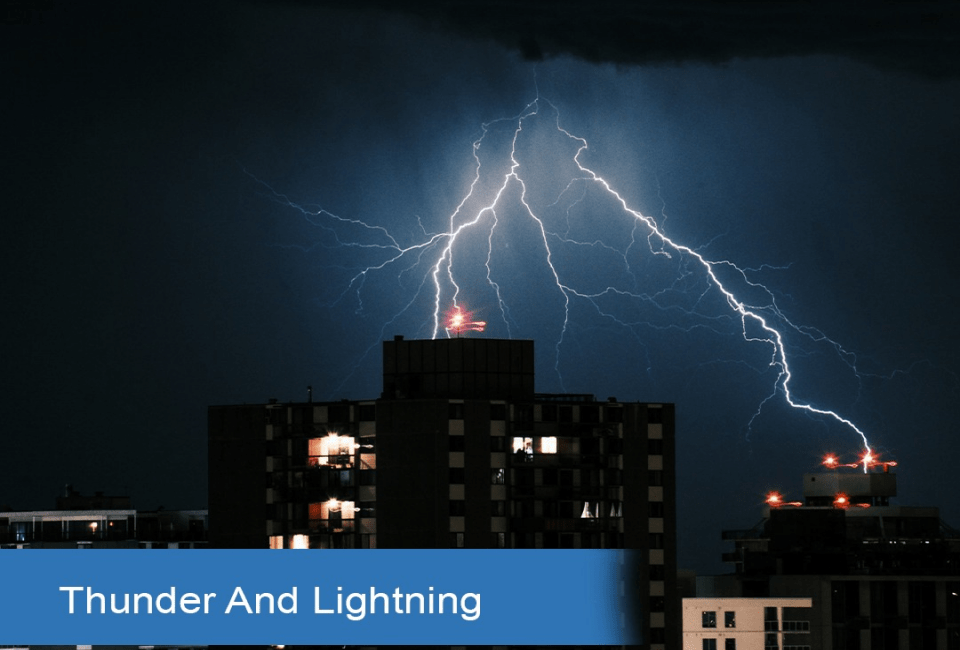
The Importance Of Weather Observations For Schools
October 6, 2022
Weather Advisory For Agriculture To Increase Farmer’s Income
October 14, 2022Is a thunderstorm’s most stunning and dangerous effect lightning? Thunderstorms acquired their name from this. What, you say, does thunder have to do with lightning? Thunder is caused by lightning.
Lightning is an electrical discharge. A single lightning strike may heat the air surrounding it to 30,000°C. The air expands explosively rapidly as a result of the intense temperature. The expansion produces a shock wave, which then transforms into a booming sound wave known as thunder.
Here, we look at lightning and thunder in-depth and try to understand their differences.
Let’s Start!
What is Lightning?
Lightning is a burst of electrical energy that looks like a huge spark. It may happen between clouds as well as between clouds and the earth. Plasma formed by a lightning strike causes the light we see.
During a thunderstorm, the cloud's bottom gets negatively charged, while the earth begins to become positively charged. This imbalance is what causes a current to flow. When the imbalance becomes too large, it creates a lightning bolt to remedy the imbalance.
Lightning is quite hazardous. A lightning strike is approximately five times hotter than the sun’s surface because the air around it is heated to 30,000°C by lightning.
In The US, other natural catastrophe deaths such as hurricanes and tornadoes, have a total death toll much more than the number of Americans killed by lightning each year. Thunderstorm-caused flash floods outnumber lightning strikes in terms of fatalities.
What is Thunder?
Thunder is the sound made by a thunderstorm. You may hear it up to 25 miles distant from the source of the lightning strike.
A lightning bolt is required to produce thunder. Lightning’s great heat causes the bolt’s air to expand so quickly that a shock wave forms almost immediately. Near the source, the wave is powerful and loud.
Because air delays sound, a lightning bolt generates an aggressive yet rapid thunderclap when the event is nearby. Not as much sound has yet been suppressed and spread out. As the sound travels and collides with additional air, it becomes a rumbling.
The sound of thunder varies based on the storm and its proximity. It crackles at moments, rumbles, and makes every sound. This depends on the distance from the original lightning strike. People who are still in the path of the storm will hear a long rumble of thunder.
What’s The Main Difference?
Lightning causes thunder, but thunder does not cause lightning. Both are interdependent, yet they are distinct occurrences.
Thunder is acoustic energy, whereas lightning is electrical energy. When lightning strikes, the surrounding air heats to tremendous temperatures. The rapid expansion of the heated air generates a shock wave, which finally transforms into the sound you hear.
Thunder and lightning strike at the exact moment. Since light travels quicker than sound, you see lightning first. Lightning travels about 270 million miles per hour, but sound travels at just 768 miles per hour.
Scientists utilize microphones placed at various sites and information on environmental conditions to examine lightning. This is done to locate the exact location of a lightning strike. In addition, it is possible to view the precise channel of the lightning strike by building a model based on the site of the noises.
Conclusion
Thunderstorms and lightning strikes can be incredibly dangerous. According to NWS Storm Data, the United States has averaged 43 lightning fatalities per year over the previous 30 years. As a result, to protect yourself and your loved ones, you need an early warning tool like Vyomet. As a result, many unwanted losses can be prevented, both in terms of money and health.




